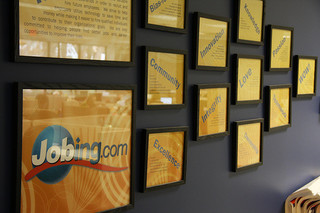Link: http://workitsmart.blogspot.com/2012/05/enabling-better-communications-with.html
From Work IT Smart
 |
| A pretty BMW car. photo credit: marco_dmoz |
Physical Models: Powerful visual cues for enabling better communications
BMW’s innovation centre in Munich is designed with deep considerations on how to encourage innovation and collaborations between employees. One key feature of the building is full scale prototypes of the current cars in development placed in a highly visible central space, so that all the different teams– engineering, sales, marketing etc–can see the prototypes. This visual cue brings great value to the company, as various teams are aware of the latest design and progress of the project, and consequently teams are on the same page when having discussions about a particular car model.
How Physical Models relate to Enterprise Architecture
What does this mean for EA?
 |
| Core values of a company framed on the wall. photo credit: videography |
- People are already doing it! When I thought about examples of physical EA models, I thought of views like an enterprise’s core values and strategic objectives. I then recall seeing various organizations putting these information on banners and big billboards, and display them at prominent places like the lobby.
- Help departments communicate their value, by helping them build physical models of their key views so that they can better communicate what they do. If the organization has regular knowledge sharing sessions, teams can use these physical models as show-and-tell tools. At other times, display these models at prominent places near to the team’s workspace. Possible views to use are a department’s key processes, how they inter-relate and how they support the organization’s objectives.
- Help projects communicate progress. Develop physical models for major projects, like in BMW’s case, as visual cues of project progress, current design, etc. Again, here is an opportunity for EA to validate data in the EA repository, and also provide values to project teams. The challenge though is how can the physical model be regularly updated to reflect project progress? Some thinking will be needed to work this out.
- New way for EA to provide value and to engage. Provide tools and the needed information (from the EA repository!) to generate the physical models. This is a good opportunity for the Enterprise Architecture team to engage the rest of the enterprise in validating data in the enterprise architecture repository. The most straightforward physical models are simply poster print-outs of key views. The periodic table of visualization methods provides a good list of visualization ideas. Or how about using cardboard boxes and styrofoam to showcase views like key business processes and technologies? Another idea is to experiment with 3D printers since they are becoming widely available for under USD2000!